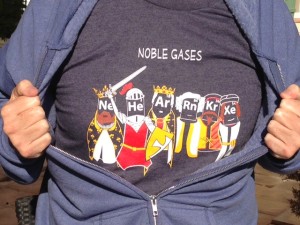Whenever helium gets in a fix, whenever neon is at risk, whenever argon and krypton and xenon and radon are ganged up on by the other 110 chemical elements … and we know they are pretty much inert … “Nobleman” is ready to shed his civilian dress and come to the rescue.
Those six elements constitute the Noble gases … so-called because they are very stable, usually inert and “very suitable in applications where reactions are not wanted”.
Noble gases are not going to do something crazy; helium is not going to go all flammable and bring down a dirigible. Krypton’s green incarnation has an odd thing with Superman (which is why Nobleman is needed), but that’s about it for irrational behavior by these guys.
And that’s what the chemical world needs … a bunch of elements who are predictably inert.
My daughter is married to a chemist (a Princeton Ph.D chemist, thank you), which is a bit amusing because my knowledge of chemistry is probably about a 4 on a scale of 100.
I went out of my way to avoid chemistry in high school; I tested out of high school biology and chemistry while in eighth grade (how that happened, I have no idea), and all these decades later I know almost nothing about chemistry.
Now and then I ask my son in law to describe his work, and I appreciate his trying to bring it down to dimwit level, so I can perhaps grasp it.
At one point, he was trying to pull nitrogen out of the atmosphere so it could be used in applications like fertilizer.
(How you make a gas a solid and spread it in your garden, I have no idea.)
I once asked him “which is your favorite element?” — and I have no idea if chemists think that is a particularly silly question, but he responded fairly quickly with molybdenum — and follow the link if you want to see why that might be. Maybe the high melting point?
So, anyway, the T-shirt has introduced me to the Noble gases and, as you can see, they are the royalty of chemistry.


0 responses so far ↓
There are no comments yet...Kick things off by filling out the form below.
Leave a Comment